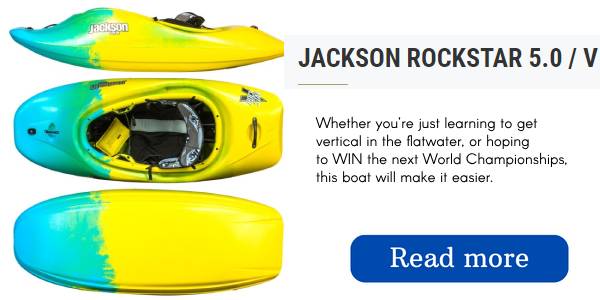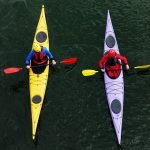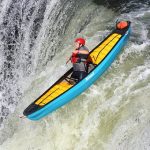Kayaks are usually propelled using a two-bladed paddle , alternating strokes on each side of the boat.
Canoes are typically paddled with a single-bladed paddle . A variety of techniques are used to keep a canoe moving straight through the water, from skilled paddle strokes to switching sides with the paddle periodically.
The most significant difference between kayaks and canoes is that canoes are open on top. Kayaks have decks covering the top of the boat and a cockpit where the paddler sits. Canoes have an open design stiffened with gunwales and thwarts.
Paddlers usually sit lower in kayaks, closer to the water, in a seat with a backrest. Most canoes have seats mounted higher off the bottom of the hull, so the paddler can sit or kneel, depending on the situation.
Kayaks often have hatches and bulkheads that provide floatation and storage for camping equipment. Touring kayaks intended for open water paddling frequently have a rudder or skeg to help paddlers control them in the wind.
Canoes rarely feature rudders and are generally simpler and lighter than kayaks of the same size and style. Their open design makes it easy to load them with large packs, barrels or coolers for camping.
Canoe pros and cons
Canoe pros
The most significant advantages of canoes have to do with cargo capacity, portaging and weight.
Canoes typically have more cargo capacity than similarly sized kayaks and are easier to pack. The open design of canoes makes them easy to load with large packs, coolers, barrels, family members or your canine companion.
Kayaks have less cargo capacity and must be loaded through small hatches, so they’re less practical for transporting bulky gear.
Many popular canoe routes involve portaging, which means to carry your canoe from one lake to another. The best strategy for portaging involves putting your camping gear into a few large dry packs that are easy to manage on the trail.
These packs are quick to load in and out of a canoe, but would be impossible to stuff into a typical kayak. A canoe can also be fitted with a portaging yoke, which allows them to be carried down the trail by one person.
It’s much easier to portage a canoe this way than it is to carry a kayak down the portage trail. If you are headed on a trip that requires portaging, a canoe is usually superior to a kayak.
Weight is the final factor where canoes have the edge over kayaks. Canoes are not always lighter than kayaks, but they often are. The absence of large decks on canoes reduces the weight of canoes.
This makes it possible for a larger canoe to weigh the same as a smaller kayak. Tandem canoes often weigh the same or less than similarly sized solo touring kayaks made of the same material, which makes them a favorite for paddling with a friend.
Weight is a big advantage for portaging, but it’s also helpful for everyday use when carrying your boat to the put-in or loading it onto and off of vehicles.
Canoe cons
The most significant disadvantages of canoes are their performance in the wind and waves, and the need to learn a few paddle strokes to control them efficiently.
Canoes are usually harder to paddle in the wind than kayaks. The open design of canoes catches more wind and creates more drag than the closed design of kayaks. Canoes are also deeper than kayaks and paddlers sit higher in the boat than they do in kayaks.
These factors combine to make canoes more challenging to control in strong winds than kayaks.
Big waves are another challenge for canoes. If waves are big enough, they can splash over the bow or the stern of a canoe, filling it with water.
Specialty whitewater canoes deal with this problem by filling the canoe with large airbags, but the decks on kayaks do a better job of keeping water out. In general, kayaks handle waves better than canoes.
You can keep a canoe moving straight by switching sides with your paddle or using a two-bladed kayak paddle, but most people choose to learn a few specialty paddle strokes to help control their canoe.
Learning canoe strokes isn’t difficult, but it is an extra step beginners need to consider when they’re choosing a new boat. It’s easier to jump into a kayak for the first time and go where you want to go than it is to do the same thing in a canoe.
Kayak pros and cons
Kayak pros
The biggest advantages of kayaks are their ease of use and their performance in wind and waves.
Kayaks use a two-bladed paddle and alternate forward strokes on either side of the boat. This makes it more intuitive to keep a kayak moving straight through the water than a canoe. Touring kayaks with rudders are even easier to use—you just press with your foot and your kayak goes in that direction.
These factors make it easier to get into a kayak for the first time and have success controlling the boat.
The covered design of kayaks makes them easier to control in the wind. Kayaks are also shallower than canoes, and the paddler sits closer to the water. This means kayaks catch less wind and have less wind drag than canoes.
When the wind is howling, a kayak is much easier to control than a canoe.
Kayaks also have an advantage in large waves. Waves that would swamp a canoe roll off the decks of a kayak. Kayaks with small cockpits can be fit with sprayskirts keeping water out even if a wave washes over the deck of the boat.
Skilled kayakers can paddle their boats in surf or turbulent whitewater without swamping, and those who have learned to roll can right their boats after a capsize without getting water into the cockpit. When it comes to waves, kayaks usually outperform canoes.
Kayak cons
The most significant disadvantages of kayaks are weight and limited storage capacity.
Kayaks can be heavier than canoes. Decks, bulkheads, comfortable seats and hatches all add weight. This means even smaller recreational kayaks can tip the scales at weights that make them difficult for some people to lift onto the roof of the car for transport.
Specialized materials can lower the weight of kayaks dramatically, but these materials can also be used to build remarkably light canoes. Any way you slice it, on average, a kayak will weigh more than a similarly sized canoe made from the same materials.
Decks, hatches and bulkheads make kayaks more seaworthy, but they also make them more challenging to load. The small hatch openings in kayaks require packing camping gear in multiple, small dry bags.
These bags are then loaded into the kayak one at a time until the storage compartments are full. This arrangement works fine for coastal touring trips where you’ll only load and unload the kayak once per day.
It doesn’t work as well for trips with multiple portages like those found in the Boundary Waters Canoe Area Wilderness or Quetico Wilderness.
13 Differences Between Canoe VS Kayak
The main difference between Canoe vs kayak lies in structure, shape, storage, and stability. A Kayak is designed to be used primarily in freshwater or for touring. It has a narrow, pointed bow and stern, a flat bottom, and a shallow draft.
A Canoe is typically wider than a kayak and has more of an oval shape to its hull with rounded ends and flared sides at the bow and stern (known as “rocker”).
The cockpit of the Kayak is fitted with bungee cords to hold the paddler’s feet in place. A kayak is designed for one person (or two or three-person) who paddles it by using a double-bladed paddle.
The hull of the canoe may have no rocker at all (known as “flat bottom”) or have a quite pronounced rocker that helps it travel faster through the water.
Canoeing is a sport that involves paddling with two blades on either side of a narrowboat. In contrast, kayaking is done in a wider boat with one blade on each side.
Kayaks are also more stable and easier for beginners to use since they can balance their weight better in these boats.
The main difference between the two boats is their width, but there are many other minor things that differentiate them as well!
Keep Reading To Learn More About The 13 Differences Between Canoe And Kayak.
| Serial | Canoe | Kayak |
|---|---|---|
| 1. | Canoes can carry more people. | Kayak carries fewer people compared to Canoe. |
| 2. | Need some expertise to maneuver. | Kayaks are faster an.d easier to maneuver than canoes |
| 3. | Bit narrow compared to Kayak. So, less stable. | Kayaks are usually wider than most canoes and offer better stability in the water. |
| 4. | A canoe is typically shorter than a kayak; this makes it slower but also easier to turn around on rivers or lakes. | Typically longer than Canoe. |
| 5. | Canoes are often more stable and easier to get in and out of. | It a bit harder to get in and out. |
| 6. | A canoe is heavier than a kayak when filled with water | Lighter in weight even with some water in it. |
| 7. | Canoes are usually made of wood. | Kayaks are typically made of plastic or fiberglass. |
| 8. | Canoes do not have a rudder for steering. | Kayaks have a rudder for steering in the water. |
| 9. | In a canoe, you row with two paddles on either side of the boat. And the paddle is called “J Stroke” Paddle or single paddle. | In a kayak, you use one paddle per hand but it’s a double paddle with blades on both ends. |
| 10. | A canoe has seats that face each other. | While a kayak does not have seats that face each other. |
| 11. | The average weight capacity for a canoe is 400 lbs. | While the average weight capacity for a kayak is 250 lbs. |
| 12. | Comes with an Open Cockpit (most of the time) | Comes with a Closed Cockpit (most of the time) |
| 13. | A Bench like seating arrangement | Seat attached to the bottom of the kayak surface. |
Historical Differences Between Kayak And Canoe
The history of kayaking and canoeing is quite different. You need to apply separate techniques to canoeing and kayaking. As a result, you have to learn canoeing and kayaking differently.
Most importantly, kayaking and canoeing have their own different kinds of waterways.
Kayaks Part
The history of kayaks goes back as far as 4000 years. It was during when the Native people in the Arctic regions of North America first built them. The kayaks, then, used to be crafted with either whalebone or driftwood.
Animal skins were stretched across the kayak. Caribou fat or whale was used to produce the waterproof feature.
The first people recorded to have had used kayaks were the Inuit people. Kayaks were primarily then, used by the Inuit people for hunting. However, the Inuit people had crafted larger kayaks for transport purposes as well.
The Inuit people used to live closer to the icy environment. Researchers believe that the enclosed design of the kayaks originated from the Inuit people’s protection. The enclosed design of the kayaks was possibly meant to keep the paddlers and their belongings dry.
This also proved effective for keeping people warm. The Inuit people might have primarily used the kayaks on the water for food, clothing, and shelter.
Another benefit of such design is worth mentioning is that the design proved effective for maneuvering through the icy water. The kayaks generate a little disturbance while going through the icy water. This lets the kayakers make a more successful trip.
In the 1800s, kayaks gained much prominence among Arctic explorers and sportsmen alike. Europeans were also heavily involved with kayaking then. In 1936, kayaking was featured as an official Olympic sport at the Berlin Olympics.
Is canoeing or kayaking easier?
A single-bladed canoe paddle requires the paddler learn a steering stroke or switch sides to keep their canoe going straight. It isn’t difficult to learn a few strokes, or to switch sides, but many people find that it takes a little more time to get a feel for canoeing rather than kayaking.
The two-bladed kayak paddle alternates forward strokes on either side, and most people who jump into a kayak figure out how to get it moving and pointed in the right direction quickly. What’s more, some kayaks have rudders, which allow you to steer the boat with your feet while paddling forward.
The combination of the double-bladed paddle and rudder make it easy to get the hang of kayaking as a beginner. Add to this the fact that kayaks are less affected by wind and waves, and a case can be made that kayaking is easier than canoeing.
Fishing from canoe vs kayak
You can fish from a canoe or kayak, but the choice of which to use depends on where you’ll be paddling. If you’re traveling in classic “Canoe Country,” like the Boundary Waters of Minnesota and Ontario, you’ll want a canoe for efficient portaging.
In these situations, you’ll fish from a canoe because it’s the best tool for the trip, not necessarily because canoes are preferred as fishing craft.
Similarly, if you’re hiking in to a remote lake to fish, you may prefer an ultralight canoe to a heavier kayak.




